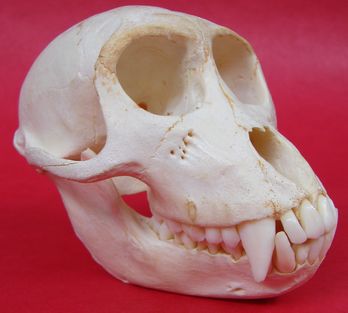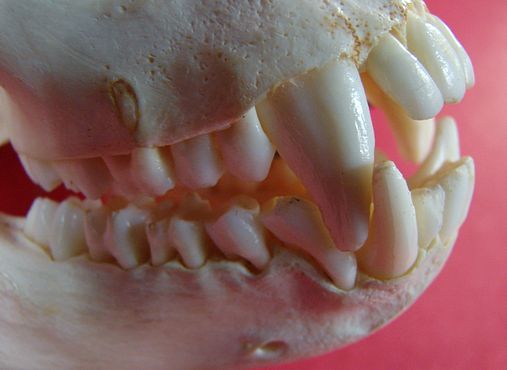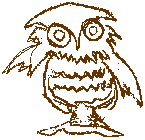In general, modern humans differ from modern great apes and from earliest proto-human forms in having (1) thicker tooth enamel, (2) differing rates of enamel deposition during the animal's development, and (3) somewhat different forms in individual teeth. Also, earliest proto-human forms, like other primates, had far larger canine teeth than we have.

The diagram at the right provides a basic vocabulary used in discussing teeth.
- The upper and lower incisors close over each other in a kind of scissors action and are used for cutting. (In most animals, including other primates, they meet, but do not overlap.)
- The canine teeth (one on each side top and bottom) are much smaller in humans than in many other animals. In animals where they are large, they are generally used for grasping and piercing. Even in humans, the canine teeth have deep, strong roots, which you can feel as a "ridge of bone" if you put your finger in your mouth and run it over your gums. (Some writers include canines as a specialized kind of incisor.)
- Premolars and molars are used for crushing and grinding. Premolars have two cusps (and hence are sometimes called bicuspids), while molars have four. When the diet contains a great deal of grit, molars often become heavily worn, with a flat surface, sometimes even abraded down almost to the gum line.
Each type of tooth is numbered from the front of the mouth to the back (second incisor, first molar, etc.). (Since some other animals have four premolars rather than our two, our two are referred to in some contexts as the third and fourth premolars, rather than the first and second.) The third (backmost) molar or "wisdom tooth" emerges later than other teeth in modern humans. It is located so far back as to be of only occasional significance in chewing, and apparently the lack of selective pressure has resulted in a tolerance for mutated forms such that wisdom teeth often come in crooked or not at all. Most dentists today do not bother replacing them when they fall out or are removed.

Carnivorous animals and animals which depend upon intimidating displays of real or mock aggression to maintain dominance hierarchies generally have prominent canines (used in attacking and in ripping carcasses apart) and incisors (used in slicing off bits of meat). The photos here show the teeth of a largely vegetarian Formosan Macaque, with its prominent canines. Although for carniverous animals the molars have a role in crushing bones or in tenderizing the meat before it is swallowed, they tend to be smaller among meat eaters than in vegetarian animals.
In vegetarian animals grinding becomes more important, and we tend to see a reduction in the proportion of the jaw given over to incisors (and especially canines) and an increase, sometimes a very large increase, in the size of the molars.

In looking at proto-human fossils, there seems to be a long-term transformation in the dentition associated with such factors as the need for greater grinding efficiency because of harder, drier foods in the late Miocene and early Pliocene geological epochs. This has consequences for the duration of infant care while appropriate teeth are developing.
Pre-hominid forms had large upper canine teeth (as do modern monkeys), and they "sharpened" or "honed" them slightly by subtle abrasion against the "third" lower premolar as the mouth opened and closed, as shown in the detail at the right. This is referred to as the "C/P3 honing complex." Its disappearance is taken by some scholars as representing, jointly with substantial bipedalism, the beginning of the hominid line of descent.
Human populations often make use of the teeth as a "third hand" to hold materials being worked on with both hands. Some peoples also use the teeth to soften skins or plant fibers used to make clothing or other materials. Such uses over time produce distinctive, sometimes severe, wear on the teeth.
For an external link showing a contrast in the roots and internal structure of incisors (used to cut) and molars (used to grind), click here.
